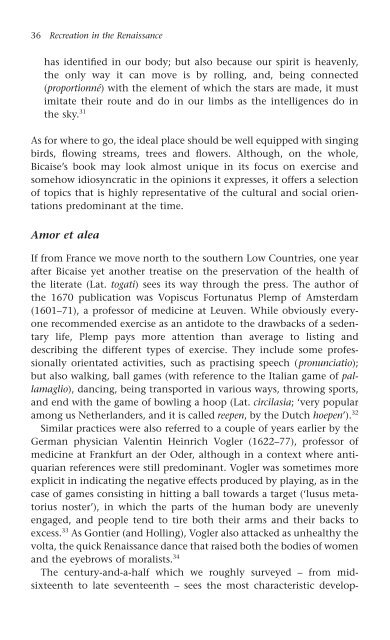Recreation in the Renaissance
Recreation in the Renaissance
Recreation in the Renaissance
- No tags were found...
You also want an ePaper? Increase the reach of your titles
YUMPU automatically turns print PDFs into web optimized ePapers that Google loves.
36 <strong>Recreation</strong> <strong>in</strong> <strong>the</strong> <strong>Renaissance</strong><br />
has identified <strong>in</strong> our body; but also because our spirit is heavenly,<br />
<strong>the</strong> only way it can move is by roll<strong>in</strong>g, and, be<strong>in</strong>g connected<br />
(proportionné) with <strong>the</strong> element of which <strong>the</strong> stars are made, it must<br />
imitate <strong>the</strong>ir route and do <strong>in</strong> our limbs as <strong>the</strong> <strong>in</strong>telligences do <strong>in</strong><br />
<strong>the</strong> sky. 31<br />
As for where to go, <strong>the</strong> ideal place should be well equipped with s<strong>in</strong>g<strong>in</strong>g<br />
birds, flow<strong>in</strong>g streams, trees and flowers. Although, on <strong>the</strong> whole,<br />
Bicaise’s book may look almost unique <strong>in</strong> its focus on exercise and<br />
somehow idiosyncratic <strong>in</strong> <strong>the</strong> op<strong>in</strong>ions it expresses, it offers a selection<br />
of topics that is highly representative of <strong>the</strong> cultural and social orientations<br />
predom<strong>in</strong>ant at <strong>the</strong> time.<br />
Amor et alea<br />
If from France we move north to <strong>the</strong> sou<strong>the</strong>rn Low Countries, one year<br />
after Bicaise yet ano<strong>the</strong>r treatise on <strong>the</strong> preservation of <strong>the</strong> health of<br />
<strong>the</strong> literate (Lat. togati) sees its way through <strong>the</strong> press. The author of<br />
<strong>the</strong> 1670 publication was Vopiscus Fortunatus Plemp of Amsterdam<br />
(1601–71), a professor of medic<strong>in</strong>e at Leuven. While obviously everyone<br />
recommended exercise as an antidote to <strong>the</strong> drawbacks of a sedentary<br />
life, Plemp pays more attention than average to list<strong>in</strong>g and<br />
describ<strong>in</strong>g <strong>the</strong> different types of exercise. They <strong>in</strong>clude some professionally<br />
orientated activities, such as practis<strong>in</strong>g speech (pronunciatio);<br />
but also walk<strong>in</strong>g, ball games (with reference to <strong>the</strong> Italian game of pallamaglio),<br />
danc<strong>in</strong>g, be<strong>in</strong>g transported <strong>in</strong> various ways, throw<strong>in</strong>g sports,<br />
and end with <strong>the</strong> game of bowl<strong>in</strong>g a hoop (Lat. circilasia; ‘very popular<br />
among us Ne<strong>the</strong>rlanders, and it is called reepen, by <strong>the</strong> Dutch hoepen’). 32<br />
Similar practices were also referred to a couple of years earlier by <strong>the</strong><br />
German physician Valent<strong>in</strong> He<strong>in</strong>rich Vogler (1622–77), professor of<br />
medic<strong>in</strong>e at Frankfurt an der Oder, although <strong>in</strong> a context where antiquarian<br />
references were still predom<strong>in</strong>ant. Vogler was sometimes more<br />
explicit <strong>in</strong> <strong>in</strong>dicat<strong>in</strong>g <strong>the</strong> negative effects produced by play<strong>in</strong>g, as <strong>in</strong> <strong>the</strong><br />
case of games consist<strong>in</strong>g <strong>in</strong> hitt<strong>in</strong>g a ball towards a target (‘lusus metatorius<br />
noster’), <strong>in</strong> which <strong>the</strong> parts of <strong>the</strong> human body are unevenly<br />
engaged, and people tend to tire both <strong>the</strong>ir arms and <strong>the</strong>ir backs to<br />
excess. 33 As Gontier (and Holl<strong>in</strong>g), Vogler also attacked as unhealthy <strong>the</strong><br />
volta, <strong>the</strong> quick <strong>Renaissance</strong> dance that raised both <strong>the</strong> bodies of women<br />
and <strong>the</strong> eyebrows of moralists. 34<br />
The century-and-a-half which we roughly surveyed – from midsixteenth<br />
to late seventeenth – sees <strong>the</strong> most characteristic develop-










